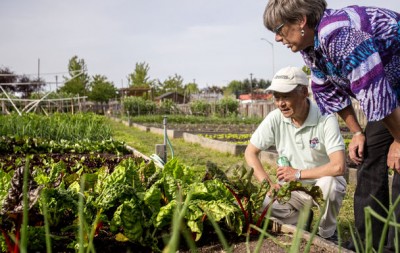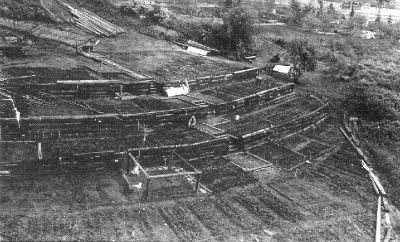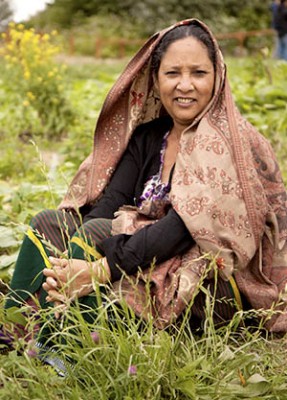Seattle has a farmers market scene that would make any green citizen proud. So why are there only white people there?
Farmers market season in Seattle is in full swing. The cheese samples and Rachel’s Ginger Beer are flowing.
At the Neighborhood Farmers Market Alliance and the Seattle Farmers Market Association locations around Seattle, there’s everything from local, organic and non-organic seasonal produce to specialty artisan bakeries, cheeses, and jams. In the peak of spring, you’ll see greens abound, radishes, peas, leeks, and short bursts of asparagus and broccoli rabe.
Something you’ll also see is a lot of white people.
Farmers markets tend to be whiter spaces than grocery stores. This is (unsurprisingly) a result of the economics behind them: the cost of producing local, organic food on small farms results in a meaningful price differential.
At the end of the day, shopping at a farmers market for a large family is still a cost prohibitive act. You won’t find many immigrant and refugee families shopping where healthy food is the priciest.
There is also an urban planning issue: The two umbrella market organizations only host markets as far south as Columbia City and as far north as Lake City. Gentrification and soaring costs of living have pushed longstanding communities of color south, and lead newer immigrants and refugees to settle on the fringes of Seattle, far from the main farmers markets.
But if you look closely, you’ll find countless places around our region where international communities are taking the issue of healthy, affordable and culturally relevant fruits and vegetables into their own hands. In many cases they were doing so long before formal farmers markets surged onto the scene over the last 18 years.
Below is a sampling of some of these families’ other creative, resilient, and culturally-rich approaches to getting produce:
New Holly Market Garden, Rainier Valley

Just last week, our own Sarah Stuteville published this article in the Seattle Times about a brand new CSA growing over an unused basketball court in the New Holly housing development on Rainier Avenue.
The patch, started by many of the Asian immigrant and refugee families living in the development, grows vegetables hard to find in regular markets in Seattle: amaranth, varieties of bok choy, beets and carrots.
They currently have 43 members of their CSA, in partnership with another P-Patch program.
Seattle Tilth Farm Works, Auburn
A unique farm incubator program hosted by Seattle Tilth and funded by the USDA’s Beginning Farmer Rancher Development Program, provides small-farm business training and support to immigrants, refugees, and people with limited resources in South King County.
Participants, mostly Somali Bantu, Ethiopian, and Burudian immigrants, are supported to create farm-related business plans and have access to farmland, advice and connections to the marketplace.
Students learn and utilize farming techniques on a plot of land in Auburn owned by Seattle Parks and Recreation.
Lee’s Fresh Produce, Redmond
Walking up and down the aisles of the produce section in any store in the International District, one wonders just how far a Jackfruit or a bag of Rau Ram travels to get there.
In search of a local farm that sells to these stores, everyone from the Hmong flower vendors in Pike Place Market to community workers on Jackson street had the same name to offer: Lee’s Fresh Produce.
Lue and Pha Lee started off leisurely growing vegetables for their family, plus a little extra for the Asian Counseling and Referral Services food bank, realizing that many of the crops from their farming tradition would grow well in the Northwest.
In 1993, the Lee backyard garden turned into a family farm business, selling vegetables out of the back of a van to local farmers markets.
Today, what started as a 5-acre farm is now a 40-acre operation in Redmond, providing wholesale produce to the Pike Place Market, International District grocery stores, and to neighboring Asian flower farms and other families looking for pesticide-free, healthy produce of Asian and non-Asian varieties.
They are one of the few local farms growing produce like daikon radish, pea vines, kabocha squash, and other items found in stores like Viet Wah, the Dong Hing Market, and Uwajimaya, as well as farmers markets serving diverse cities like Renton and Tacoma.
The Lee children have now stepped up to run the family business, which continues to promote traditional farming practices that regenerate soil, rotate crops, and result in healthy, organic foods for the community.
The Danny Woo Garden, The International District

One of the most longstanding urban farming operations in Seattle, the Danny Woo Garden has been growing Asian produce in the heart of the International District since 1975.
The garden was started by Bob Santos and the Interim Community Development Association that has for years advocated for the housing rights of families in the International District.
The story goes as follows: Bob Santos, who had long been fielding requests for a garden from residents of the CDA’s low-income housing buildings, approached a local business owner about a vacant plot of land.
When the man, Danny Woo asked how much Santos would pay for the plot, he told him that as a non-profit just barely scraping by, he could offer $1. Woo found Santos’s intentions compelling, and agreed to lease the land, now bearing his name, for that price.
Today there are 100 garden plots with 65 gardeners, mostly Korean and Chinese residents of the neighborhood. Many arrived in Seattle with seeds from their home countries that they continue to propagate: daikon, shiso, bok choy, watercress, Asian pear, and countless greens that grow well in a climate that mirrors many of the countries of origin represented in the International District.
Today, the garden employs a coordinator, hosts community work parties, a summer pig roast and has a children’s garden for educational activities.
Got Green, South King County
Since 2008, Got Green has had their finger on the pulse of all food-related issues in South King County. They act as the voice for food and job needs for some of the longstanding communities of color and newer immigrant and refugee communities who have settled there.
One of their biggest projects this year was advocating for the Fresh Bucks program to be incorporated into the city budget permanently, (a recent win!).
According to Jill Mangaliman, lead organizer at Got Green (and Globalist contributor), the Columbia City farmers market offers culturally appropriate produce and international vendors to serve the incredibly diverse neighborhood.
Got Green affiliates were invited to give testimony at the City budget hearings, on how the program has helped families eat better in the neighborhood.
The organization has also been active in advocating for similar food programs farther south where communities cannot access the benefits of central Seattle markets, and encouraging an incoming PCC to do its part to cater to lower-income families who live in the area.
All of these efforts are ensuring that the diverse communities who live in South Seattle have a voice in mainstream food markets and grocery stores.
The Namaste Garden, Tukwila
An unlikely partnership between the International Rescue Committee, Forterra, and St. Thomas Parish in 2010 has resulted in a fully-functional, refugee-powered garden in Tukwila.

Fifty-four 10 x 20 ft. plots of land are parsed out to 90% IRC clients, mostly Bhutanese and Burmese. Dal Diyali, a coordinator at the IRC Seattle Headquarters, serves as the garden president and liaison between the gardeners and organizational partners.
According to Dal, the garden serves a specific need for the community of elderly refugees arriving from rural farming communities, many of whom have felt isolated in the transition to urban Seattle, with few job or language skills.
The garden is a public space for both the young and elderly to meet, socialize, and continue the practice of growing produce like mustard greens, diakon radish, pumpkin, okra, green carrots, and other produce enjoyed by Bhutanese and Burmese communities, absent from most grocery stores.
Recognizing the skills that so many refugees arrive with around food and agriculture, the IRC has launched a new national program, New Roots in America, helping recently re-settled refugees connect with community gardening, nutrition, and small business ventures.
Looking to get involved? The Danny Woo Garden, The International Rescue Committee and Got Green all take volunteers!


